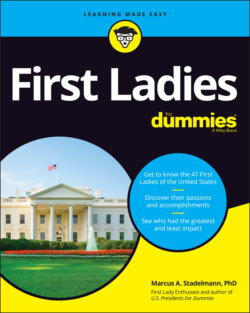Читать книгу First Ladies For Dummies - Marcus A. Stadelmann, Marcus A. Stadelmann PhD - Страница 24
Phase IV (1933–Present)
ОглавлениеIn the 20th century, with wars and the second industrial revolution, the role of women dramatically changed in the U.S. This brought about a change in the role First Ladies performed and also changes in American culture. Here is where the modern era for First Ladies began. They became public figures pursuing their own causes, which made them not only more famous but also resulted in the media scrutinizing them even more. (Check out Part 5 for these First Ladies.)
Then, after 1960, First Ladies’ roles changed rapidly one more time. For the first time, First Ladies started campaigning for their husbands, even on their own, which previously had been considered not proper. Today, First Ladies campaigning for their husbands hasn’t just been accepted but is expected. In addition, First Ladies today are expected to pick a public cause to focus on, which in turn gets them involved in political issues. They truly have become a first partner to today’s presidents. By now, First Ladies often outstrip their husbands in popularity, emotional access by the public, and even book sales.
In the beginning, First Ladies were mostly nonpartners in their husband’s presidencies, and today they have become full partners. They are now equal in not just social or charitable matters but also in political matters. From Edith Wilson to Eleanor Roosevelt to Hilary Clinton, First Ladies have become trusted allies and advisors for their husbands and have asserted themselves independently.
Today, many First Ladies are highly educated, have professional portfolios, and have ambition to seek political office. Traditionally, a First Lady’s background has impacted how influential and assertive she will be.
Educational achievement and professional experience are great predictors on how strong First Ladies will be. Based on this, it’s possible to predict that future First Ladies will be more independent, more politically involved, and possibly more controversial in the public’s eyes compared to the First Ladies of the past.
